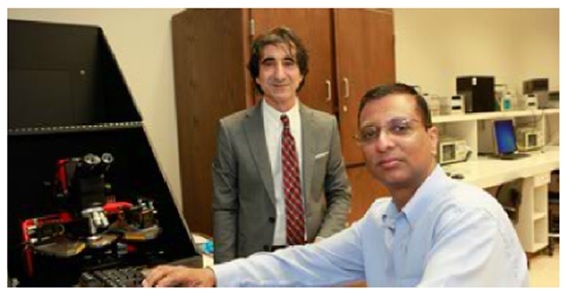KINGSVILLE (April 23, 2021) — Drs. Amit Verma and Reza Nekovei, professors in the electrical engineering and computer science department at Texas A&M University-Kingsville, are listening. In a new paper, recently published in the Nature journal, Scientific Reports, Verma and Nekovei say it is now possible to hear electrons as they travel through a device.
In their paper, On the feasibility of hearing electrons in a 1D device through emitted phonons, they claim that electrons traveling through a one-dimensional material like a carbon nanotube, causes vibrations in the atoms in the carbon nanotubes with sufficient power to be detected by modern instruments. They were joined in the writing of this paper by Dr. Zahed Kauser of Intel.
“This essentially means that these electrons can be heard as they travel through a device,” Verma said. “The background for this discovery was work done by Dr. Kauser and me nearly 15 years ago when we looked at how electrons behave in different carbon nanotubes.”
Carbon nanotubes are tubes made of carbon atoms with thickness on the scale of nanometers. A nanometer is about 50,000 times thinner than a human hair, he explained.
“When electrons move through any material, they cause vibrations in atoms that make up those materials. How do we hear someone talking? The vocal cords of the person doing the talking set up vibrations in the air molecules. This same principle is involved in a tin can telephone, only in this case, the vibrations are set up in the chord connecting the two tin cans,” Verma said. “The vibrational power in all these cases has to be higher than the background noise and also high enough for the ears to pick it up.”
“When electrons move through any material, they cause vibrations in atoms that make up those materials. This is one major reason for electrical resistance and electrical heat,” Verma said. “What we found was that in carbon nanotubes, this effect of causing vibrations is very pronounced and causes the speed of electrons to oscillate very drastically over relatively long lengths.”
Verma said he didn’t think much about this again until spring 2017 when it hit him on the drive home. “It suddenly struck me that instead of focusing on electrons, if we focus on the vibrations the electrons cause, we may be able to detect those electrons as they move through the carbon nanotube.
“It did not quite know how to go about calculating the generation and movement of those vibrations. It took another two years and long discussions with eminent researchers before I realized what needed to be done,” Verma said. “What was needed was a very massive, data-intensive code on top of another very massive, data-intensive code, where all electrons and atom vibrations in the carbon nanotube are tracked using principles of quantum mechanics and classical physics.”
This is where Dr. Nekovei and his expertise on running massive computer codes on super computers came into the picture. For this work, they used the supercomputing facility at the Texas Advanced Computing Center in Austin over about eight months. “It was after all that, that we obtained our results that proved our initial hypothesis,” he said.
“What we found is that at ultra-low temperatures where background atomic vibrations are essentially absent, electrons passing through a carbon nanotube device are the overwhelming cause of vibrations in the atoms, some of which also travel like ripples in a pond,” Verma said. “These traveling vibrations reach the end of the device and deliver energy that is within the sensitivity of modern instrumentation.
“We believe this phenomenon is more challenging to observe in 2D or bulk 3D materials because of the nature of vibrations that are generated, but this is something certainly worth exploring,” he added.
As for the importance of their discovery, Verma said it opens up the possibility of encoding information, not just in electrons, but also in the vibrations they cause.
“These are still the early days in this research. We are excited about what lies ahead,” Verma said.
-TAMUK-

